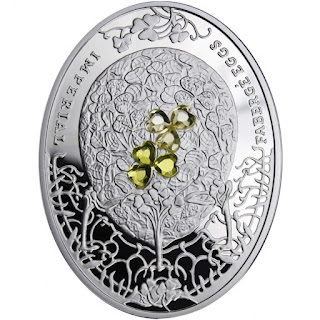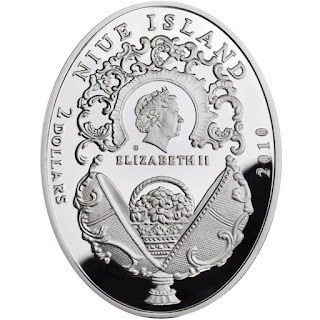Niue Island 2 Dollar Silver Coin 2010 Clover Leaf Faberge Egg
Series: Imperial Fabergé Eggs
Imperial Fabergé Eggs, known also as Tsar’s Fabergé Eggs, are considered masterpieces of the jeweller’s art and a symbol of extravagance and luxury. Created by Peter Carl Fabergé and his assistants for tsars: Alexander III and Nicholas II of Russia, the eggs were made of gold and silver and decorated with enamels and precious stones.
“Clover Leaf Egg” coin is the third coin of the popular series “Imperial Fabergé Eggs”. Low mintage, unique design, glass inserts and zircons arranged in the shape of clovers, make the coin highly attractive for collectors.
Obverse: At the bottom – open Spring Flowers Egg (1899-1903) with a miniature basket of wood anemones inside. Above – the effigy of Her Majesty Queen Elizabeth II with the mint’s mark (m/w) and the inscription “ELIZABETH II” below. Around the Queen’s effigy – decorative neorococo scroll ornament. At the top – the issuer’s name: NIUE ISLAND. On the right – a nominal value of the coin (2 dollars), on the left – year of issue (2010).
Reverse: In the center – the image of the “Clover Leaf Egg” with green glass inserts and zircons arranged in the shape of two clovers. On the left side of the egg – an inscription: IMPERIAL. On the right side of the egg – an inscription: FABERGÉ EGGS. At the bottom, in the background – a delicate Art Nouveau ornament. At the top – a stylized relief with clover leafs.
Designer: Robert Kotowicz
Country: Niue.
Denomination: 2 NZD.
Metal: Silver.
Silver Fineness: Ag 925/1000.
Content: 1.82 Troy OZ.
Weight: 56.56 g.
Diameter: Ellipse 41.6 x 55.6 mm.
Year of Issue: 2010.
Quality: Proof.
Mintage: 7,000.
Exterior Decoration: Zircons and Elements in Polished Finish.
Producer: Mint of Poland (Mennica Polska).
Series: Imperial Fabergé Eggs
Clover Leaf Egg 1902 Faberge Peter the Great Egg 1903 Faberge
Clover Leaf Egg
The Clover Leaf Egg is a jewelled Easter egg made under the supervision of the Russian jeweller Peter Carl Fabergé in 1902 for Tsar Nicholas II of Russia. It was presented by Nicolas II as an Easter gift to his wife, the Tsarina Alexandra Fyodorovna. It is currently held in the Kremlin Armoury Museum in Moscow, and it is one of the few Fabergé eggs that have never left Russia.
Design
The Clover Leaf Egg is made of an openwork pattern of stems and leaves of clover forming the shape of an egg. The gaps between the metal outline of the leaves are covered with transparent bright green enamel. A very thin golden ribbon paved with rubies curls through the foliage. At the time, the production of transparent enamel was still a new method, and often suffered from problems while cooling. There are no flaws in the enamel of the Clover Leaf Egg, but it is considered too fragile to travel.
Surprise
The surprise in the egg has been lost but according to archives it is reported to be a four leaf clover with twenty three diamonds, and four miniature portraits of the four daughters of the Tsar: Olga, Tatiana, Maria, and Anastasia.



